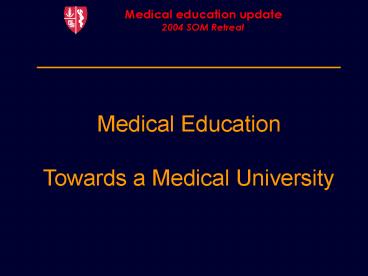PowerPoint Presentation Medical Education Towards a Medical University - PowerPoint PPT Presentation
1 / 28
Title:
PowerPoint Presentation Medical Education Towards a Medical University
Description:
Initiated new Faculty Senate Committee on Performance Assessment and Advising ... Neil Gesundheit (Office of Medical Education) Betsy Porter (OME) ... – PowerPoint PPT presentation
Number of Views:64
Avg rating:3.0/5.0
Title: PowerPoint Presentation Medical Education Towards a Medical University
1
Medical Education Towards a Medical University
2
Major Accomplishments 2003
- Initiated the new curriculum
- New courses
- Scholarly concentrations
- Curriculum evaluation plan
- Initiated new Faculty Senate Committee on
Performance Assessment and Advising - High yield on admissions
- Exceptional residency match in 2003
- Initiated new funding mechanism for CME office
3
Emphasis of the New Stanford Curriculum
- A scholarly anchor for each student
- Interweaving of basic science and clinical
concepts - Doctor/patient communication and clinical care
- Flexibility to accommodate individual learning
- Advising and mentoring to proactively develop
students
4
Scholarly Concentrations
Years of Medical School
5
Scholarly Concentrations-- academic anchor
- Analogous to a major
- Provides opportunity for independent, creative
scholarly experiences - Critical thinking
- Skills in evaluation of data
- Hands-on experience
- Interwoven throughout years of medical curriculum
- Inter-school, inter-disciplinary
6
Scholarly concentrations and directors
7
Scholarly Concentrations -- Options
- Original Research Track
- Requires 5 years or more for completion
- Curriculum within a discipline (100-150 hours)
- Attendance at seminar/journal club
- Conduct of significant scholarly work
- funded for equivalent of 1 full year
- Possible portal into MA or PhD program
- Scholars Track
- Possibly complete in 4 years
- Curriculum as above
- Original term paper (50-100 hours)
8
Pathway through Scholarly Concentrations
Complete Scholars Paper
Scholars Track
SQ2
SQ3
SQ1
Select Concentration (Spring, year 1)
OrientationsSampling
Complete Original Research Project
SQ2 SQ4
SQ1
Original Research Track
SQ1 SQ4
Course work
9
(No Transcript)
10
(No Transcript)
11
(No Transcript)
12
(No Transcript)
13
(No Transcript)
14
(No Transcript)
15
Overview of New Medical Curriculum
16
How can this work?
- Added 5 weeks to medical school (2.5 weeks for
each of the first two years) - Eliminate excessive course redundancy
- Recapture inefficiently used time in clerkships
- Free up blocks of time for individual study and
for SC electives
17
Curriculum Evaluation Plan
Evaluation Logic Model
Curriculum Goals
Curriculum Elements Methods
Faculty Views
OUTCOME Competent Graduates
Student views
External Measures of student performance
18
Curriculum Evaluation Plan
19
Curriculum Evaluation Plan
20
Objectives for 2004
- Curriculum
- Institute second year of the curriculum
- Develop curriculum for clinical years
- Add additional scholarly concentrations
- Institute student portfolios
- Implement evaluation program
- Improve student evaluation
- Integrate residents and fellows into scholarly
concentrations - Develop mechanisms to facilitate and foster
teaching - Adapt existing education support
- Identify funds for scholarly concentrations
- Develop CME program
- Provide proactive service to the Stanford
community and beyond
21
Clinical Clerkship Retreat II, January 16th
- Goals
- Bring translation to medical education science
at the bedside - Improve consistency to medical student education
between hospitals - Establish distinct medical student and resident
curricula
22
Integrating basic and clinical sciences in
clerkships
- Intersessions. Themes might revolve around
- Scholarly concentrations
- Institutes
- Diseases
- Applied basic sciences
- Enhanced flexibility with elective clerkships
23
Performance on USMLE Step II
24
California Clinical Skills Exam
25
Enhancing clinical skills
- Faculty development
- Expansion of Practice of Medicine
- Standardized day curriculum for each clerkship
- Expanded standardized and virtual patient
experiences - Physical exam electives
26
Substantial challenges
- Transition running two curricula simultaneously
- Financial strain
- Student morale
- Human resource limitations
- Interdepartmental courses
- Structure of financing
- Leadership
- Scholarly concentration
- Costs
- Too much choice
27
Summary
- Curriculum is exciting and speaks to the mission
of the school - Public image does not yet match the curriculum
- Meeting our goal of establishing the Medical
University
28
Leadership in education
- Oscar Salvatierra (Faculty Senate)
- Theodore Sectish (CCC)
- Neil Gesundheit (Office of Medical Education)
- Betsy Porter (OME)
- Pat Youngblood (Evaluation plan)
- Ross Bright (CME)
- Gary Schoolnik (Scholarly Concentrations)
- Pat Cross (Scholarly Concentrations)
- Al Lane (CPAA)































